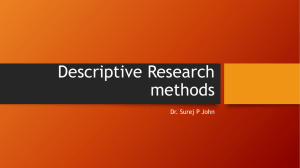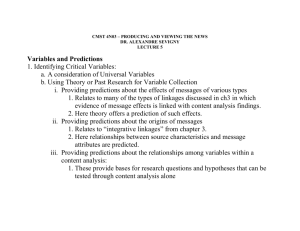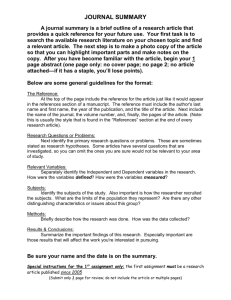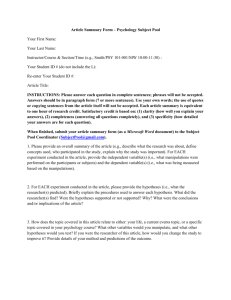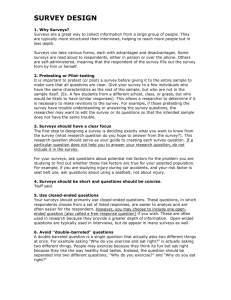Class Note 3: Conceptual model & Descriptive research designs
advertisement
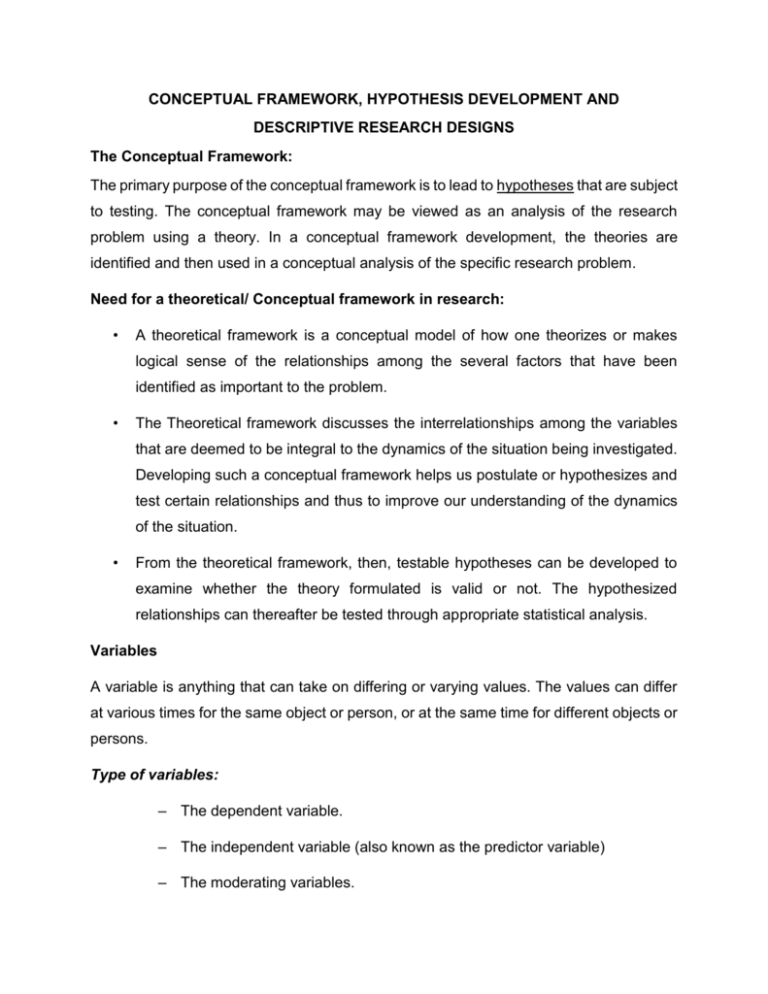
CONCEPTUAL FRAMEWORK, HYPOTHESIS DEVELOPMENT AND DESCRIPTIVE RESEARCH DESIGNS The Conceptual Framework: The primary purpose of the conceptual framework is to lead to hypotheses that are subject to testing. The conceptual framework may be viewed as an analysis of the research problem using a theory. In a conceptual framework development, the theories are identified and then used in a conceptual analysis of the specific research problem. Need for a theoretical/ Conceptual framework in research: • A theoretical framework is a conceptual model of how one theorizes or makes logical sense of the relationships among the several factors that have been identified as important to the problem. • The Theoretical framework discusses the interrelationships among the variables that are deemed to be integral to the dynamics of the situation being investigated. Developing such a conceptual framework helps us postulate or hypothesizes and test certain relationships and thus to improve our understanding of the dynamics of the situation. • From the theoretical framework, then, testable hypotheses can be developed to examine whether the theory formulated is valid or not. The hypothesized relationships can thereafter be tested through appropriate statistical analysis. Variables A variable is anything that can take on differing or varying values. The values can differ at various times for the same object or person, or at the same time for different objects or persons. Type of variables: – The dependent variable. – The independent variable (also known as the predictor variable) – The moderating variables. – The mediating variables. The Dependent variable The dependent variable is the variable of primary interest to the researcher. The researcher’s goal is to understand and describe the dependent variable, or to explain its variability, or predict it. It is the main variable that lends itself for investigation as a viable factor. Through the analysis of the dependent variable, it is possible to find answers or solutions to the problem. The Independent variable An independent variable is the one that influences the dependent variable in either a positive or negative way. That is, when the independent variable is present, the dependent variable is also present, and with each unit of increase in the independent variable, there is an increase or decrease in the dependent variable also. (the variance in the dependent variable is accounted for by the independent variable. The Moderating variable The moderating variable is one that has a strong contingent effect on the independentdependent variable relationship. That is, the presence of a third variable (the moderating variable) modifies the original relationship between the independent and the dependent variables. For example, the relationship between Sales promotion and Purchase intention are influenced or affected by the salary or wealth of the individual. Here Sales promotion is the independent variable and purchase intention is the dependent variable. Salary is the moderator. Sales Promotion Purchase intention Salary of the individual Mediating variable A mediating variable is also known as intervening variable. In statistics, a mediating variable refers to the variable that explains how, rather than when an effect will occur by accounting for the relationship between the independent and dependent variables. For example, the brand loyalty is surely depend on the product quality, but product quality leads to customer satisfaction and customer satisfaction leads to brand loyalty. Customer satisfaction Brand Loyalty Product Quality In the above conceptual model, relationship between Product quality and Brand loyalty is mediated by customer satisfaction. Hypotheses and hypotheses testing A primary function of the conceptual framework is to lead to hypotheses relevant to the research problem. Hypotheses result from the reasoning done in the conceptual framework. • Hypotheses need to be testable and refutable. • Hypotheses are tentative assertions that are subject to testing. • Hypotheses can take the form of a simple proposition of an expected outcome, or can assert the existence of a relationship • Quantitative hypotheses are subject to empirical testing, the most common form being a statistical test Conceptual framework example: The above Conceptual model presented above clearly shows the variables under the study. The researcher tests the factors influencing an individual’s choice selecting a college for his/ her studies. We can write the hypotheses of this model as given below. H1: There is a relationship between cost of the studies and college choice decision H2: There is a relationship between Location and college choice decision H3: There is a relationship between High School personnel and college choice decision H4: There is a relationship between Peers and friends and college choice decision H5: There is a relationship between Programs offered and college choice decision H6: There is a relationship between Campus visit and college choice decision. DESCRIPTIVE RESEARCH: SURVEY AND OBSERVATION Descriptive research, is used to describe characteristics of a population or phenomenon being studied. It does not answer questions about how/when/why the characteristics occurred. Rather it addresses the "what" question (What are the characteristics of the population or situation being studied?) Survey and observation are the two common research methods in practice. Survey methods The survey method of obtaining information is based on questioning respondents. Perhaps the biggest issue researchers’ face is how to motivate respondents to candidly answer their questions. Questions regarding behavior, intentions, attitudes, awareness, motivations, and demographic and lifestyle characteristics all lend themselves to survey research. Main advantages of Survey methods: • Ease: Questionnaires are relatively easy to administer. • Reliability: Using fixed-response (multiple-choice) questions reduces variability in the results that may be caused by differences in interviewers and enhances reliability of the responses. • Simplicity: It also simplifies coding, analysis, and interpretation of data. Disadvantages • Respondents may be unable or unwilling to provide the desired information. • Structured data collection involving a questionnaire with fixed-response choices may result in loss of validity for certain types of data, such as beliefs and feelings. • Properly wording questions is not easy. Classification of Survey Methods Personal In-Home Interviews • Respondents are interviewed face-to-face in their homes. • The interviewer's task is to contact the respondents, ask the questions, and record the responses. • In recent years, the use of personal in-home interviews has declined. Mall-Intercept Personal Interviews • Respondents are intercepted in shopping in malls. • The process involves stopping the shoppers, screening them for appropriateness, and either administering the survey on the spot or inviting them to a research facility located in the mall to complete the interview. • While not representative of the population in general, shopping mall customers do constitute a major share of the market for many products. Computer-Assisted Personal Interviewing (CAPI) • The respondent sits in front of a computer terminal and answers a questionnaire on the screen by using the keyboard or a mouse. • Help screens and courteous error messages are provided. • The colorful screens and on- and off-screen stimuli add to the respondent's interest and involvement in the task. Self-Administered Surveys This is a data collection technique in which the respondent reads the survey questions and records his or her own answers without the presence of a trained interviewer. Advantages: • Low cost per survey • Respondent control • No interviewer-respondent bias • Anonymity in responses Disadvantages • Minimum flexibility • High non response rate • Potential response errors • Slow data collection • Lack of monitoring capability Mail Surveys A typical mail interview package consists of the outgoing envelope, cover letter, questionnaire, postage-paid return envelope, and possibly an incentive. • Those individuals motivated to do so complete and return the questionnaire through the mail. • There is no verbal interaction between the researcher and the respondent. • Individuals are selected for cold surveys through mailing lists the client maintains internally or has purchased commercially. • The type of envelope, the cover letter, the length of the questionnaire, and the incentive (if one is offered) all affect response rates. Mail Panels • Once the individuals have been admitted to the panel, detailed demographic and lifestyle data are collected on each household. • The researcher uses this information to select targeted mailing lists within the panel based on client needs. Email Surveys • If the addresses are known, the survey can simply be mailed electronically to respondents included in the sample. • Respondents key in their answers and send an e-mail reply. • Email surveys are especially suited to projects where the email lists are readily available, such as surveys of employees, institutional buyers, and consumers who frequently contact the organization via email (e.g., frequent fliers of an airline). Internet Surveys: • An Internet survey is a questionnaire posted on a Web site that is self-administered by the respondent. • The questions are displayed on the screen and the respondents provide answers by clicking an icon, keying in an answer, or highlighting a phrase. • Web survey systems are available for constructing and posting Internet surveys. • The researcher can obtain at any time survey completion statistics, descriptive statistics of the responses, and graphical display of the data. • As compared to email surveys, Internet surveys offer more flexibility, greater interactivity, personalization, automatic skip patterns and visual appeal. • Several Web sites, such as WebSurveyor, surveymonkey, Google form etc. allow users to design surveys online without downloading the software. A Classification of Observation Methods: Personal Observation: • A researcher observes actual behavior as it occurs. • The observer does not attempt to manipulate the phenomenon being observed but merely records what takes place.
